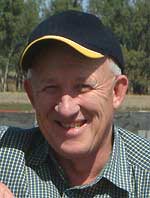Australia
June 2, 2005
A
retired agronomist whose work led to improved productivity in
the acid soils of central-west New South Wales and to widespread
grower adoption of grain legumes and oilseeds has won this
year’s “Seed of Light” award for grains research communications
in the northern region.
 Col Mullen
(photo) received his “Seed of Light” from the deputy chairman
of the Grains Research and
Development Corporation (GRDC) Northern Panel, Di Bentley,
at a ceremony on Tuesday night. Col Mullen
(photo) received his “Seed of Light” from the deputy chairman
of the Grains Research and
Development Corporation (GRDC) Northern Panel, Di Bentley,
at a ceremony on Tuesday night.
The award is made annually by the GRDC, with the prize a work of
art in glass by Stephen Procter, head of the Canberra School of
Art class workshops at the Australian National University.
Ms Bentley said Mr Mullen’s almost 40 years of research and
extension with the NSW Department of Agriculture had been worth
millions of dollars of extra production to growers across the
state.
“Col Mullen’s impact on agriculture in NSW has been enormous,
and he is rightly regarded by his colleagues as a leader amongst
his peers and an exceptionally effective research and extension
officer,” Ms Bentley said.
“Col was the first person in central and northern NSW to
research the area’s big percentage of inherently infertile,
vulnerable, acid soils and show how they could be managed
sustainably and productively.
“His recipe of relatively low rates of lime and other missing
nutrients and adapted pasture legumes and grasses substantially
altered the trend of increasing acidification. Further on he
discovered legumes like serradella and sub and Arrowleaf clovers
that thrived on these soils.”
Ms Bentley said Col Mullen had also led the development of the
canola and grain legume industries in the NSW central west. He
had shown that lupins, field peas, chickpeas and faba beans
suited different soil types and environments and promoted canola
by identifying suitable varieties and demonstrating sustainable
production techniques like sowing into cereal straw.
Mr Mullen’s researching of the nutritional deficiencies of the
many soil types across the central west led to the
identification of suitable pasture species for them, and his
work in this area has been recognised right across the state.
“Col was also the first to show that a mixture of lime and
gypsum would dramatically improve the structure of the sodic
soils of the central west, opening the way for productive
pastures on them,” Ms Bentley said.
“He brought the same skills to the cereal industry, which
largely has him to thank for the meaningful soil tests growers
now use to make their fertiliser decisions as well as the most
sustainable and profitable crop rotations.”
Ms Bentley said previous NSW winners of the GRDC’s Seed of Light
award were Tamworth plant pathologist Kevin Moore and climate
researcher Peter Hayman. |